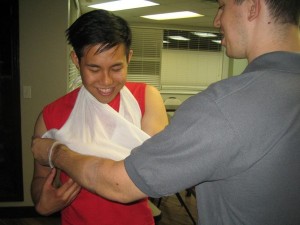Broken arms occur when there is a crack or break
in one or more of the three bones present in the arm.It is a fairly common injury in both children and adults.It does not have great protection from muscles or other soft tissues, thus, direct blowsor low-energy mechanisms can easily lead to a fracture. There are three bones in the arms. The humerus is the only bone in the upper arm, while there are two bones in the forearm, radius and ulna. Broken arms are used interchangeably with fractured arms.
Simple fractures can be treated with a splint or cast, however, severe fractures may require surgery. Although, always seek for medical attention immediately with regard to any fracture, including arms, only proper treatment can lead to complete healing. Complete healing usually takes a few weeks.
Broken Arm Causes
Although it is fairly common to acquire this injury, the common causes of broken arms are the following:
- High-energy injury causing significant trauma
- Motor vehicular accidents
- Bike accidents
- Direct application of force to a part of the arm
- Low-energy mechanism
- Falls, especially in an outstretched hand or elbow
- Sports injuries
- Especially from direct contact sports
- Child abuse
Broken Arm Symptoms
It is usually quite evident when someone breaks their arm. Symptoms are similar to those of any fractured bone in the body.
- A snap felt or pop heard at the time of the injury
- Pain, which increases with movement
- Tenderness
- Swelling and bruising thatgenerally appears within 30 minutes of injury
- Difficulty moving the arm or inability to move the arm at all
- Inability to turn the arm from palm up to palm down.
- Stiffnessanywhere in the injured arm
- Numbness or tingling sensation
- Cool, pale or cyanosis of the elbow, forearm or arm of the affected side
- Decreased pulse or no pulse detected
- Deformity
- Possible open wound
Broken Arm First Aid Management

- If an open wound is present, apply firm pressure to the bleeding area using a dry, clean cloth. If possible, elevate the affected arm above heart level.
- To minimize swelling, place a cold compress to the swollen area. In the first 24 hours, place the cold compress on the affected area for 20 to 30 minutes every hour. Do not apply ice directly to the skin.
- Immobilize the fractured area. Stabilize the arm by creating a sling. If one is trained to apply a splint, do so.
- Do not attempt to move the bone to its original position as it may just lead to further complications. If the bone is protruding, do not attempt to push back.
Disclaimer: This article is for information purposes only and not meant to substitute for medical advice or formal training. To learn how to treat and manage broken arms and other fractures in the body, enroll in First Aid Training.
